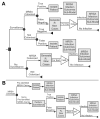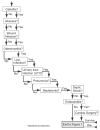Universal methicillin-resistant Staphylococcus aureus (MRSA) surveillance for adults at hospital admission: an economic model and analysis
- PMID: 20402588
- PMCID: PMC3385994
- DOI: 10.1086/652524
Universal methicillin-resistant Staphylococcus aureus (MRSA) surveillance for adults at hospital admission: an economic model and analysis
Abstract
Background: Methicillin-resistant Staphylococcus aureus (MRSA) transmission and infections are a continuing problem in hospitals. Although some have recommended universal surveillance for MRSA at hospital admission to identify and to isolate MRSA-colonized patients, there is a need for formal economic studies to determine the cost-effectiveness of such a strategy.
Methods: We developed a stochastic computer simulation model to determine the potential economic impact of performing MRSA surveillance (ie, single culture of an anterior nares specimen) for all hospital admissions at different MRSA prevalences and basic reproductive rate thresholds from the societal and third party-payor perspectives. Patients with positive surveillance culture results were placed under isolation precautions to prevent transmission by way of respiratory droplets. MRSA-colonized patients who were not isolated could transmit MRSA to other hospital patients.
Results: The performance of universal MRSA surveillance was cost-effective (defined as an incremental cost-effectiveness ratio of less than $50,000 per quality-adjusted life-year) when the basic reproductive rate was 0.25 or greater and the prevalence was 1% or greater. In fact, surveillance was the dominant strategy when the basic reproductive rate was 1.5 or greater and the prevalence was 15% or greater, the basic reproductive rate was 2.0 or greater and the prevalence was 10% or greater, and the basic reproductive rate was 2.5 or greater and the prevalence was 5% or greater.
Conclusions: Universal MRSA surveillance of adults at hospital admission appears to be cost-effective at a wide range of prevalence and basic reproductive rate values. Individual hospitals and healthcare systems could compare their prevailing conditions (eg, the prevalence of MRSA colonization and MRSA transmission dynamics) with the benchmarks in our model to help determine their optimal local strategies.
Conflict of interest statement
Figures




Similar articles
-
Clinical effectiveness and cost benefit of universal versus targeted methicillin-resistant Staphylococcus aureus screening upon admission in hospitals.Infect Control Hosp Epidemiol. 2011 Aug;32(8):797-803. doi: 10.1086/660875. Infect Control Hosp Epidemiol. 2011. PMID: 21768764
-
Cost-effectiveness analysis of active surveillance screening for methicillin-resistant Staphylococcus aureus in an academic hospital setting.Infect Control Hosp Epidemiol. 2012 May;33(5):477-86. doi: 10.1086/665315. Epub 2012 Mar 21. Infect Control Hosp Epidemiol. 2012. PMID: 22476274 Review.
-
Cost-effectiveness of strategies to prevent methicillin-resistant Staphylococcus aureus transmission and infection in an intensive care unit.Infect Control Hosp Epidemiol. 2015 Jan;36(1):17-27. doi: 10.1017/ice.2014.12. Infect Control Hosp Epidemiol. 2015. PMID: 25627757 Free PMC article.
-
Screening cardiac surgery patients for MRSA: an economic computer model.Am J Manag Care. 2010 Jul 1;16(7):e163-73. Am J Manag Care. 2010. PMID: 20645662 Free PMC article.
-
Rapid detection of methicillin-resistant Staphylococcus aureus directly from clinical samples: methods, effectiveness and cost considerations.Ger Med Sci. 2009 Jul 6;7:Doc06. doi: 10.3205/000065. Ger Med Sci. 2009. PMID: 19675746 Free PMC article. Review.
Cited by
-
Trends in Staphylococcus aureus bacteraemia and impacts of infection control practices including universal MRSA admission screening in a hospital in Scotland, 2006-2010: retrospective cohort study and time-series intervention analysis.BMJ Open. 2012 Jun 8;2(3):e000797. doi: 10.1136/bmjopen-2011-000797. Print 2012. BMJ Open. 2012. PMID: 22685226 Free PMC article.
-
A systematic literature review and meta-analysis of factors associated with methicillin-resistant Staphylococcus aureus colonization at time of hospital or intensive care unit admission.Infect Control Hosp Epidemiol. 2013 Oct;34(10):1077-86. doi: 10.1086/673157. Epub 2013 Aug 19. Infect Control Hosp Epidemiol. 2013. PMID: 24018925 Free PMC article.
-
Cost-effectiveness analysis of whole-genome sequencing during an outbreak of carbapenem-resistant Acinetobacter baumannii.Antimicrob Steward Healthc Epidemiol. 2021 Dec 13;1(1):e62. doi: 10.1017/ash.2021.233. eCollection 2021. Antimicrob Steward Healthc Epidemiol. 2021. PMID: 36168472 Free PMC article.
-
Cost Effectiveness of Mirabegron Compared with Antimuscarinic Agents for the Treatment of Adults with Overactive Bladder in Colombia.Pharmacoecon Open. 2020 Mar;4(1):79-90. doi: 10.1007/s41669-019-0149-9. Pharmacoecon Open. 2020. PMID: 31168754 Free PMC article.
-
Tannic acid inhibits Staphylococcus aureus surface colonization in an IsaA-dependent manner.Infect Immun. 2013 Feb;81(2):496-504. doi: 10.1128/IAI.00877-12. Epub 2012 Dec 3. Infect Immun. 2013. PMID: 23208606 Free PMC article.
References
-
- Beretta AL, Trabasso P, Stucchi RB, Moretti ML. Use of molecular epidemiology to monitor the nosocomial dissemination of methicillin-resistant Staphylococcus aureus in a university hospital from 1991 to 2001. Braz J Med Biol Res. 2004;37(9):1345–1351. - PubMed
-
- Harbarth S, Sax H, Fankhauser-Rodriguez C, Schrenzel J, Agostinho A, Pittet D. Evaluating the probability of previously unknown carriage of MRSA at hospital admission. Am J Med. 2006;119(3):275.e15–275.e23. - PubMed
-
- Farr BM. What to think if the results of the National Institutes of Health randomized trial of methicillin-resistant Staphylococcus aureus and van-comycin-resistant Enterococcus control measures are negative (and other advice to young epidemiologists): a review and an au revoir. Infect Control Hosp Epidemiol. 2006;27(10):1096–1106. - PubMed
-
- Wernitz MH, Swidsinski S, Weist K, et al. Effectiveness of a hospital-wide selective screening programme for methicillin-resistant Staphylococcus aureus (MRSA) carriers at hospital admission to prevent hospital-acquired MRSA infections. Clin Microbiol Infect. 2005;11(6):457–465. - PubMed
-
- Hsu CC, Lin YE, Chen YS, Liu YC, Muder RR. Validation study of artificial neural network models for prediction of methicillin-resistant Staphylococcus aureus carriage. Infect Control Hosp Epidemiol. 2008;29(7):607–614. - PubMed
Publication types
MeSH terms
Grants and funding
LinkOut - more resources
Full Text Sources
Medical
